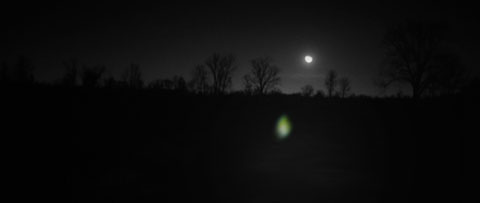Will-o'-the-Wisp
Few mythical "creatures", if you can call this one, share the kind of worldwide mythology that the will-o'-the-wisp has. In different cultures around the world, this unexplained phenomenon is known by different names and descriptions, but there are a few similarities that seem to appear in all versions of the folklore.
The most common encounters with will-o'-the-wisps occur in marshes and swampland. Travelers will see a faint but definite flame-like light in the distance. It seems to be flickering in and out of sight. Those who approach the light notice consistently that it appears to move away from them, but if they turn around and walk away, it appears to follow them. It is believed that the light wants you to follow it, but folklorists disagree as to whether it wants to help you find your way or lead you to your death.
Scientists have long suspected that these lights were simply marsh gas igniting. Small photon emissions (lights) can indeed be replicated by combining chemicals and gasses found in marshes and rotting compost.
In J.G. Owens "Journal of American Folklore", the author makes a striking point in response:
"This is a name that is sometimes applied to a phenomenon perhaps more frequently called Jack-o'-the-Lantern, or Will-o'-the-Wisp. It seems to be a ball of fire, varying in size from that of a candle-flame to that of a man's head. It is generally observed in damp, marshy places, moving to and fro; but it has been known to stand perfectly still and send off scintillations. As you approach it, it will move on, keeping just beyond your reach; if you retire, it will follow you. That these fireballs do occur, and that they will repeat your motion, seems to be established, but no satisfactory explanation has yet been offered that I have heard. Those who are less superstitious say that it is the ignition of the gases rising from the marsh. But how a light produced from burning gas could have the form described and move as described, advancing as you advance, receding as you recede, and at other times remaining stationary, without having any visible connection with the earth, is not clear to me."
Again, explanations as to what will-o'-the-wisps really are depend
highly on the context and location of the sighting. Some cultures
believe they are ghost lights, some say they are fairies, and some have
different takes altogether. They all, however, share the theory that
these are spirits or creatures that intend to guide travelers in a
certain direction.

The optimistic view is that following a
will-o'-the-wisp will lead to great treasure, much like chasing a
leprechaun, but seemingly easier. The more common, and seemingly more
realistic take is that these are the ghosts of the dead, not allowed in
either Heaven or Hell, wandering eternally and leading travelers astray
to do them harm.
Several folktales support this theory, stating
that the light one sees is a single piece of burning coal from Heaven
or a burning ember from Hell - both consolation prizes for trying, but
failing, to get in. The name jack-o'-lantern or jack-o'-the-lantern
comes from this same myth, where the burning ember is placed in a turnip
or pumpkin. This is where the tradition of guiding others to your home
by lighting a candle inside a pumpkin on Halloween night comes from.
Regardless
of their true origin or nature, my take is that if I were, for some odd
reason, out traveling in the darkness and I saw a will-o'-the-wisp, I
would probably not follow it. Of course if you are truly lost, this may
indeed seem the best course of action. Or so they would like you to
think...
Return from Will-O'-The-Wisp to the List of Mythical Creatures.
